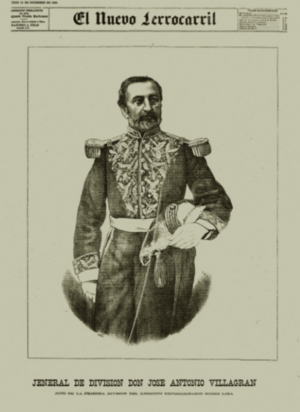José Antonio Villagrán facts for kids
Quick facts for kids
José Antonio Villagrán
|
|
|---|---|

A portrait of Villagrán depicted in El Nuevo Ferrocarril
|
|
| Born | 1821 Tucumán Province, United Provinces of the Río de la Plata |
| Died | June 17, 1895 (aged 73–74) Valparaíso, Valparaíso Region, Chile |
| Allegiance | |
| Branch | |
| Years of service | 1838 – 1880 |
| Rank | Brigadier General |
| Battles/wars | Chilean Revolution of 1851 Revolution of 1859
|
José Antonio Villagrán Correas was an important Chilean general and politician. He was born in Argentina but became a key leader in Chile, especially during the War of the Pacific. He was known for his military skills and his strong opinions on how Chile should manage its resources.
Contents
Early Life and Military Start
José Antonio Villagrán was born around 1821. In 1836, when he was about 15, he joined the Military School. Two years later, in 1838, he became a cadet in the army.
He quickly moved up the ranks. In 1838, he became a Second Lieutenant. By 1844, he was a Lieutenant. He even taught math at the Military School. Villagrán also studied engineering at the University of Chile and became a Surveyor Engineer in 1847. That same year, he was promoted to Captain. He helped stop a small uprising known as the Urriola Mutiny.
Supporting the Government
Villagrán was a loyal supporter of the Chilean government. During the Chilean Revolution of 1851, he stood with President Manuel Montt Torres. For his loyalty, he was promoted to Graduate Sergeant Major.
In 1853, he became an instructor for a civic battalion and later commanded an infantry regiment. He continued to rise, becoming a Lieutenant Colonel in 1858. He also took part in the Revolution of 1859, again supporting the government. He fought in the Battle of Cerro Grande in April 1859.
He was put in charge of keeping peace in the Atacama region and fought in battles there. He was promoted to Colonel in June 1859. During the Chincha Islands War, he led Chilean troops in the Battle of Calderilla.
Role in the War of the Pacific
When the War of the Pacific began, José Antonio Villagrán was appointed chief of the army's General Staff. He did an excellent job training the first Chilean soldiers sent to Peru.
In 1879, he became the Inspector General of the Army. Later that year, he was made Commander-in-Chief of the Reserve Army. In this role, he was in charge of the nitrate fields that Chile had taken from Peru. He strongly believed these fields should belong to the nation and not be given to private companies.
Challenges and Later Life
In August 1880, Villagrán was promoted to Division General. There was talk of him becoming the overall Commander-in-Chief of the army, but the government chose Manuel Baquedano instead.
Villagrán was then put in charge of the First Division. His division was given a very difficult task: to march through a dry, harsh region from Pisco to Lurín. Villagrán warned that the march would be very tough due to a lack of supplies. He told his superiors that if the march failed, it wouldn't be his fault. This led to a disagreement, and he was removed from his command.
After this, he became a member of a commission that evaluated military services. José Antonio Villagrán passed away on June 17, 1895, at the age of 74.
See also
 In Spanish: José Antonio Villagrán Correas para niños
In Spanish: José Antonio Villagrán Correas para niños

